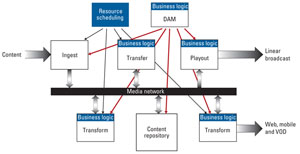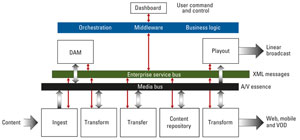SOA: The business of broadcast
Broadcasters have many challenges as the media business evolves, driven by new consumer devices and the increase in mobile viewing. National broadcasters are facing more competition from global operators. New entrants like YouTube and Netflix have changed the VOD landscape. Broadcasters that once aired one channel now air a multiplex of linear channels, as well provide catch-up and mobile services. Summing up, broadcasters must deliver to more platforms, linear and on-demand, in a more competitive business environment.
To meet these challenges, a business must become more agile. Many other sectors have faced similar challenges, and part of the solution for many has been to turn to new software applications, particularly business process management (BPM) and the service-oriented architecture (SOA). Although each can be used stand-alone, BPM and SOA are frequently used in concert as a platform to improve the performance of a business.
Operations that use videotape were constrained by the need for manual handling, but as content migrates from videotape to digital files, the way is open to use IT-based methodologies, including BPM and SOA, to aid broadcast operations.
What is SOA?
SOA is a design methodology for software systems. SOA is not a product, but an architecture to deploy loosely coupled software systems to implement the processes that deliver a business workflow. SOA provides a more viable architecture to build large and complex systems because it is a better fit to the way human activity itself is managed — by delegation. SOA has its roots in object-oriented software and component-based programming.
In the context of the media and entertainment sector, SOA can be used to implement a “media factory,” processing content from the production phase through to multi-platform delivery.
Legacy broadcast systems
Traditional broadcast systems comprise processing silos coupled by real-time SDI connections, file transfer and an assortment of control protocols. Such systems are optimized for a specific application and may provide a good price/performance ratio with high efficiency.
The professional video industry's #1 source for news, trends and product and tech information. Sign up below.
The tight coupling of legacy systems makes it difficult to upgrade or replace one or more components. These applications are typically coupled via proprietary APIs, as shown in Figure 1. If the software is upgraded to a new version, the API can change, necessitating changes to other applications that are using the API — work that is usually custom.

Figure 1. Legacy systems use many applications, all tightly coupled by proprietary APIs.
It makes it difficult to extend to add new functionality to the system to meet the ever-changing demands of multi-platform delivery and evolving codec standards. Storage architectures change with object-based and cloud storage to become alternates to on-premise NAS and SAN arrays.
When vendors upgrade products, the new versions often do not support legacy operating systems, leading to the need to replace underlying computer hardware platforms.
Traditional systems are just not agile enough to easily support the new demands of the media business. Often new multi-platform systems are tacked on to existing linear playout systems in an ad-hoc manner to support an immediate demand. The system grows in a way that eventually becomes difficult to maintain and operate.
Monitoring — no overall visibility
Traditional systems also suffer from a lack of visibility of the internal processes. Individual processes may display the status on a local user interface, but it is difficult to obtain an overall view (dashboard) of the operation of the business.
As broadcast strives for more efficiency, it is vital to have an overall view of technical operations as an aid to manage existing systems and guide future investment. Many broadcasters already have end-to-end alarm monitoring, but resource usage may only be monitored for billing purposes, and not to gain intimate knowledge of hardware and software utilization.
SOA in media
SOA is not new; it has been in use for a decade or more in other sectors including defense, pharmaceuticals, banking and insurance. It developed from the principles of object-oriented software design and distributed processing.
If SOA is common in other sectors, why not just buy a system from a middleware provider? The problem lies with the special nature of media operations. The media sector has lagged other sectors in the adoption of such systems for a number of reasons. These include the sheer size of media objects and the duration of some processes. A query for an online airline reservation may take a minute at most; a transcode of a movie can take several hours. Conventional SOA implementations are not well suited to handling such long-running processes.
What is a service?
A service is a mechanism to provide access to a capability. A transcoding application could expose its capability to transcode files as a transform service. Examples of services in the broadcast domain include ingest, transform, playout, file moves and file archiving. The service is defined at the business level rather than the detailed technical level.
It could be said that many broadcasters already operate service-oriented systems; They just don’t extend the methodology to the architecture of technical systems.
Services share a formal contract; now service contracts are commonplace in broadcasting and across the M&E sector, with companies calling on each other for capabilities such as playout, subtitling and effects, as examples. The service-level agreement for playout will include quality aspects such as permitted downtime (99.999 percent). Service contracts operate at the business level, and ultimately may result in monetary exchange.
Abstraction
The business management logic may call for a file to be transcoded from in-house mezzanine to YouTube delivery format, but not define the specifics of a particular make and model of transcoder or the detail of the file formats. This abstracts the business logic from the underlying technical platforms. A generic service interface for file transform can be defined, and then each transcoder is wrapped by a service adaptor that handles the complexity of the transcode process. To the business logic, the transcode is simply a job. The abstraction of the capability is a key principle of the SOA.
In a legacy system, the ingest job is delegated to an operator configures an encoder, and then starts and stops the encoding at the appropriate times. The operator is functioning autonomously during the processes of the job. These concepts of delegation and autonomy are key to the SOA design philosophy. The encoding may well be automated as a computer process, but the principles remain the same.
Because the service is abstracted, it opens the way for broadcasters to leverage cloud services more easily. As an example, at times of peak transcode demand, a cloud transcode service could be used to supplement in-house resources. With a standard service interface for transcoding, the implementation can be an on-premise or cloud-based service. The operation of the services is orchestrated by a layer of middleware, software that manages business processes according to the needs of the business.
A transform service can be used for different business processes. For example, a transcoder could be used to transform files at ingest to the house codec or used to create multiple versions of content for multi-platform delivery. The transform services can be redeployed to different departments as the needs of the file traffic change from hour to hour.
Planning for a SOA
Migrating from traditional tightly coupled systems to use SOA principles is a big step for a media business. The efficient operation of SOA requires detailed analysis of business needs and definition of services. It also requires rigorous planning of the IT infrastructure, computers and networks for efficient operation of the services. Without the involvement of senior management down to IT services, the benefits of SOA are unlikely to be fully realized.
For broadcasters used to running departmental silos, many with real-time elements, the move to SOA will be a radical change to the way the business operates. However, the advantages of the SOA and allied systems like BPM are proving attractive propositions for the broadcaster — or service provider — running complex file-based operations for multi-platform delivery.
The problems facing a media company looking to embrace SOA and BPM include change management and the sheer problems of keeping on-air through such huge changes in the technical infrastructure supporting broadcast operations.
Many media companies have embraced the architecture, with early adopters using considerable original development of such components as service adapters — the vital link between a service like transcoding and the workflow orchestration middleware.
The use of consultants or internal software services to build a media SOA will achieve the goal, but does it make sense for all media businesses to go their own way?
FIMS
It was this issue on which the Advanced Media Workflow Association (AMWA) and the European Broadcasting Union (EBU) independently agreed when, in 2010, they decided to pool resources and set up the joint Framework for Interoperable Media Services (FIMS) Project, which would develop standards for a framework to implement a media-friendly SOA.
The road will be long, and many obstacles remain to be resolved, but the success of this project will benefit both vendors and media companies in the long run.
The FIMS solution aims to provide a flexible and cost-effective solution that is reliable and future-proof. It should allow best-of-breed content processing products to be integrated with media business systems.
The FIMS team released V1.0 in 2012 as an EBU specification, Tech 3356. Three service interfaces have been specified: transform, transfer and capture.
The FIMS Project has expanded on the conventional SOA with additional features to meet the needs of media operations. Specifically FIMS adds asynchronous operation, resource management, a media bus and security.
Asynchronous operation allows for long-running services. A transcode may take hours; conventional SOA implementations allow for processes that complete in seconds or minutes.

Figure 2. SOA loosely couples autonomous services with a central orchestration engine calling services to deliver the business requirements.
Although services are loosely coupled to the orchestration, jobs can still be run with time constraints. This may be simply to start a job at a certain time, but services can also be real time, like the capture and playout of streams. In these cases, the job requests for the service will also include start and stop times for the process. For playout, this concept is no different from a playlist or schedule.
SOA typically is based on an enterprise service bus (ESB) that carries XML messages between service providers and consumers. A media bus provides a parallel bus to the ESB to carry the large media essence files. Many file-based operations will already have media IP networks that can be adapted to provide the platform for the media bus, as shown in Figure 2.
The future
Software methodologies like SOA and BPM help media businesses manage file-based operations in more efficient ways and better serve the needs of multi-platform delivery. They provide a holistic approach to running business operations that provide better visibility of operations and simpler ways to leverage cloud services.
They have proved successful in other sectors and are ready to meet the unique needs of the media sector.
—David Austerberry is the editor of Broadcast Engineering World.
